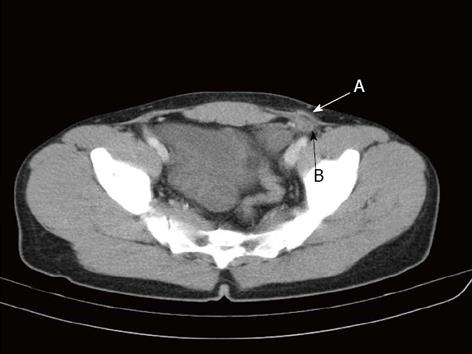Published online Oct 27, 2013. doi: 10.4240/wjgs.v5.i10.285
Revised: September 26, 2013
Accepted: October 16, 2013
Published online: October 27, 2013
Processing time: 92 Days and 10.1 Hours
The presence of the appendix in an inguinal hernia sac has been referred to as Amyand’s hernia. Vermiform appendix located in an external hernia sac is not an uncommon condition, and the incidence of these cases is approximately 1%. In Amyand’s hernias, appendices are frequently found in the hernia sac; but an incarceration particularly on the left side is a very unusual sight. In this report we present 32-year-old male with Amyand’s hernia on the left side.
Core tip: Patients with Amyand’s hernias usually present with signs and symptoms of both appendicitis and obstructed or strangulated hernia. Although a CT scan is not routinely used in the diagnosis of an inguinal hernia, it can demonstrate the malrotation of the cecum, situs inversus as well as the Amyand’s hernia
- Citation: Unver M, Ozturk S, Karaman K, Turgut E. Left sided Amyand’s hernia. World J Gastrointest Surg 2013; 5(10): 285-286
- URL: https://www.wjgnet.com/1948-9366/full/v5/i10/285.htm
- DOI: https://dx.doi.org/10.4240/wjgs.v5.i10.285
Claudius Amyand described the first case of a perforated appendix within the hernial sac in 1735 after his patient had undergone a successful appendectomy. Since then, the presence of the appendix in an inguinal hernia sac has been referred to as Amyand’s hernia[1].
In this report we present 32-year-old male with Amyand’s hernia on the left side. The main complaint of the patient was an irreducible inguinal mass with pain for three days. The other complaints of the patients were nausea and vomiting. He didn’t suffer from any significant medical disease and he had undergone a Lichtenstein hernioplasty 3 years before due to a left sided inguinal hernia. We performed an abdominal computerized tomography (CT) which showed a mobile cecum that switched to the left side of the abdomen, with co-existing inflammatory echogenic findings and a left side inguinal hernia sac including appendix vermiformis (Figure 1). The patient underwent an emergency abdominal exploration via a median inferior abdominal incision. The cecum was mobile and shifted to the left side. The appendix vermiformis was found incarcerated in the left inguinal sac. We performed an appendectomy and repaired the internal ring with primary sutures.
Vermiform appendix located in an external hernia sac is not an uncommon condition, and the incidence of these cases is approximately 1%[2]. In Amyand’s hernias, appendices are frequently found in the hernia sac; but an incarceration particularly on the left side is a very unusual sight[3]. The hernia sac commonly contains omentum or small bowel, but unusual contents such as the bladder, a Meckel’s diverticulum (Littre hernia), or a portion of the wall of the intestine (Richter hernia) are extremely rare[4]. Also, most of the Amyand’s hernias occur on the right side, because of the anatomical position of appendix. On the other hand, left-sided Amyand’s hernias may be associated with situs inversus, intestinal malrotation or a mobile cecum[4,5].
In conclusion, Patients with Amyand’s hernias usually present with signs and symptoms of both appendicitis and obstructed or strangulated hernia. Although a CT scan is not routinely used in the diagnosis of an inguinal hernia, it can demonstrate the malrotation of the cecum, situs inversus as well as the Amyand’s hernia.
P- Reviewer Canonico S S- Editor Zhai HH L- Editor A E- Editor Lu YJ
| 1. | Gupta S, Sharma R, Kaushik R. Left-sided Amyand’s hernia. Singapore Med J. 2005;46:424-425. [PubMed] |
| 2. | Khan RA, Wahab S, Ghani I. Left-sided strangulated Amyand's hernia presenting as testicular torsion in an infant. Hernia. 2011;15:83-84. [RCA] [PubMed] [DOI] [Full Text] [Cited by in Crossref: 9] [Cited by in RCA: 15] [Article Influence: 1.0] [Reference Citation Analysis (0)] |
| 3. | Breitenstein S, Eisenbach C, Wille G, Decurtins M. Incarcerated vermiform appendix in a left-sided inguinal hernia. Hernia. 2005;9:100-102. [RCA] [PubMed] [DOI] [Full Text] [Cited by in Crossref: 23] [Cited by in RCA: 23] [Article Influence: 1.1] [Reference Citation Analysis (0)] |
| 4. | Johari HG, Paydar S, Davani SZ, Eskandari S, Johari MG. Left-sided Amyand hernia. Ann Saudi Med. 2009;29:321-322. [RCA] [PubMed] [DOI] [Full Text] [Full Text (PDF)] [Cited by in Crossref: 23] [Cited by in RCA: 26] [Article Influence: 1.6] [Reference Citation Analysis (0)] |
| 5. | Turanlı S, Yüksel MU, Pirhan Y, Çetin A. Inflamed vermiform appendix within the sac of incarcerated left inguinal hernia. Ulus Travma Acil Cerrahi Derg. 2011;17:467-469. [RCA] [PubMed] [DOI] [Full Text] [Cited by in Crossref: 2] [Cited by in RCA: 2] [Article Influence: 0.1] [Reference Citation Analysis (0)] |









